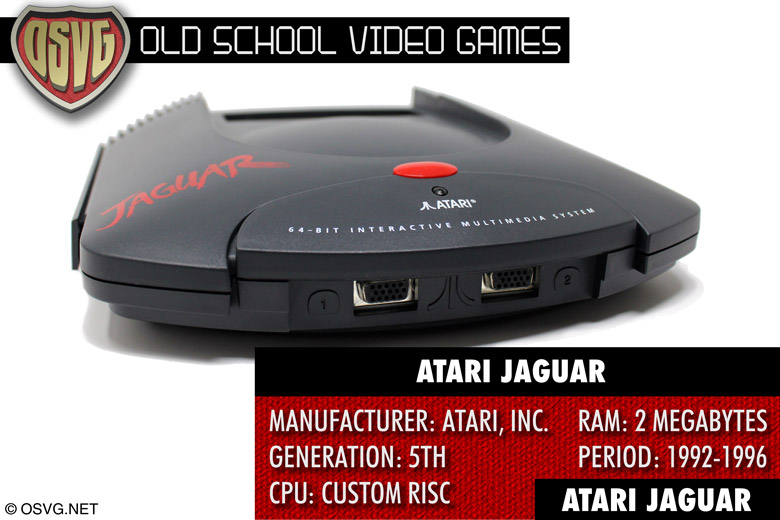Atari Jaguar
Posted on Apr 1, 2018 in Atari Jaguar

History
The Jaguar was touted as a 64-bit console due to its its custom Tom and Jerry chips both being 32-bit and, in Atari’s eyes, working as one sharing a 64-bit memory bus. There was much dispute over the accuracy of this claim, but the console was undoubtedly more advanced than most of its contemporaries in several ways. Tom encapsulated a GPU, Object processor, and Blitter. While Jerry behaved as a DSP, handling audio, I/O, and UARTs. Unfortunately, developing towards those strengths was difficult and many developers took shortcuts or simply ignored the advances in the interest of time-to-market or ease of porting.
Designed for Atari by Flare Technology, who also worked on the unreleased Panther, the console is powered by a combination of Atari’s two custom RISC chips, Tom the GPU and Jerry the DSP, and a Motorola 68000 intended as a management chip. Much to Atari’s consternation, many developers simply developed towards the 68000 and avoided many of the features and performance of the advanced, but cumbersome to program for, dual-chip environment. This led to a plethora of games which did not show off Jaguar’s power and led some to believe it was less performant than Atari claimed. A few titles which took full advantage of the architecture, however, made it clear that there was more under the hood than just a 68000. Manufacturing of the console was arranged through a deal with IBM.
The Jaguar was released in North America on November 23rd, 1993 at a US retail price of $249. A European release followed June 27, 1994, with releases in Australia, Germany, and Japan before the end of the year. Spain would not see the console officially released there until April 1995. As previously mentioned, the Jaguar sold fewer than 250,000 units during its market lifetime.
A CD-ROM add-on was released in September of 1995 and, despite its lackluster sales, the Jaguar had several peripherals and add-ons available both from Atari and third party vendors. These included the Pro controller, Memory Track cartridge, Team Tap multi-player tap, Jag-Link for networked play, Catbox A/V peripheral, among others. A working VR headset was demo’d at the 1995 Winter CES, but never made it to market. Plans for a ‘duo’ console, integrating the CD-ROM, were also scrapped due to poor sales.
Specifications
- Software Medium: Cartridge ROMs up to 6MB and CD-ROM
- Microprocessor: 32-bit custom RISC GPU (Tom) @ 26.59 MHz, 32-bit custom RISC DSP (Jerry) @ 26.59 MHz, Motorola 68000 @ 13.295 MHz
- RAM: 2 MB
- RAM Expansion: None (8MB total theoretical)
- Video Processor: 32-bt customer RISC GPU (Tom)
- Video RAM: 4K SRAM + shared DRAM
- Video Resolution: Standard resolutions, 480i (NTSC), 576i (PAL). Capable of 160 to 800 pixels per line.
- Color Depth: 24-bit
- Video Outputs: Internal RF modulator, composite, S-Video, RGB
- Video Color Palette: Up to 16,777,216 colors
- Sprites: “Unlimited” except by system resources. Object Processor via Tom chip,
- Advanced Graphics: Hardware Z-buffering and Gouraud shading
- Audio: Two-channel 16-bit stereo
- Audio Waveforms:Wavetable synthesis, FM and AM synthesis, FM sample synthesis
- Audio Outputs: Internal RF modulator, stereo card-edge cable out
- Inputs: Two 15-pin D-connectors, one 108-pin cartridge/expansion slot, one 24-pin AV edge connector, one 12-pin DSP edge connector
- I/O: Via Tom DSP chip, includes high-speed serial I/O
- Standard Controllers: Three-button, 8-way digital D-pad, 12-button keypad, pause and option buttons
- Alternate Controllers: Trak-ball, multi-button joysticks, light pen, graphics tablet
- Power Input: 9v 1.2A DC (Warning: center negative)
Games Library
- Published by Atari: 31
- Published by 3rd parties: 19
- Post-EOL Development?: Yes. New games are still being produced by homebrew developers.
The Jaguar’s biggest-selling title was, at approximately 85,000 units, the Atari-published Alien vs Predator, developed by Rebellion.
Ads

You must be logged in to post a comment.